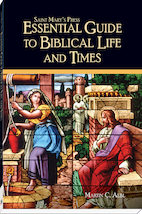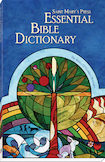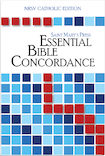Recent headlines
-
AUGUST 19, 2020
Saint Mary’s Press Pioneers Brand New Distance-Learning Options for Flexible Learning During COVID-19 Pandemic
-
APRIL 11, 2019
Saint Mary’s Press and the California Catholic Conference launch new eLearning program celebrating California Native Peoples and Missions
-
MARCH 20, 2019
Mission: Building Solidarity Across Differences
-
JANUARY 29, 2019
Singer-Towns Takes On New Role After Storied Career at Saint Mary’s Press
-
JANUARY 9, 2019
OPEN WIDE OUR HEARTS
-
JULY 12, 2018
ACTA Publications and Saint Mary’s Press Conclude Historic Sale
-
JUNE 29, 2018
Janet Zafft: A celebration of 40 years of faithful, joyful service
-
JANUARY 17, 2018
FOR IMMEDIATE RELEASE: SAINT MARY’S PRESS & GEORGETOWN RESEARCHERS RELEASE TWO-YEAR NATIONAL STUDY ON DISAFFILIATION IN YOUNG CATHOLICS
-
JANUARY 15, 2018
RELEASE: SAINT MARY’S PRESS RELEASES NEW CATHOLIC YOUTH BIBLE DESIGNED TO INSPIRE AND ENGAGE
-
JANUARY 5, 2018
RELEASE: SAINT MARY’S PRESS HOSTS A PUBLIC DISCUSSION ON WHY YOUTH ARE LEAVING RELIGION
-
SEPTEMBER 19, 2017
"A better children's bible" from Aleteia: a review of The Catholic Children's Bible
-
JULY 3, 2017
Making a difference in Ethiopia
-
AUGUST 10, 2015
Ready-To-Go Game Shows
-
JULY 8, 2015
Coming Soon! A New Translation of The Catholic Youth Bible
-
MAY 8, 2015
New type of Bible with African-American history
-
MAY 3, 2015
World Religions: A Voyage of Discovery
-
APRIL 21, 2015
Religion teacher wants students to open Bible, be surprised
-
APRIL 14, 2015
The Catholic Children's Prayer Book
-
MARCH 26, 2015
New Edition of Bible Considers African-American Catholic Faith, Youth and Community
-
JANUARY 9, 2015
New Bible is Designed Specifically for Young Black Catholics
-
DECEMBER 29, 2014
One of Us
-
DECEMBER 19, 2014
Cotter student receives free prayer book from Saint Mary's Press
-
NOVEMBER 24, 2014
Bible aims to make God's word more accessible to African-American youth
-
OCTOBER 7, 2014
Bible for African-American youth to be released
-
MAY 28, 2014
Saint Mary's Press Named Gold Winner for Benjamin Franklin Award
-
APRIL 26, 2014
Essential Guide to Biblical Life and Times
-
APRIL 21, 2014
Anselm Academic Study Bible
-
APRIL 12, 2014
The Catholic Youth Bible
-
APRIL 8, 2014
Break Through!
-
MARCH 31, 2014
Moses and the Ten Commandments Big Book
-
MARCH 30, 2014
The Catholic Children’s Bible
-
MARCH 24, 2014
Vocations: Answering God's Call
-
FEBRUARY 5, 2014
Excellent Textbook on Morality For Kids
-
JANUARY 30, 2014
Church History: Apostolic Times to Today
-
DECEMBER 13, 2013
The Catholic Children’s Bible
-
NOVEMBER 24, 2013
Catholic TV interviews John Vitek on The Catholic Children's Bible
-
AUGUST 25, 2013
Back-to-School Time Is Good Reading Time-Review by National Catholic Register
-
AUGUST 21, 2013
The Catholic Children's Bible by Saint Mary's Press-Review by Equipping Catholic Families
-
JULY 27, 2013
"Great Addition to The Catholic Children's Bible" by Stuart Dunn
-
JULY 12, 2013
The Catholic Children’s Bible by Saint Mary's Press -Review by Gidget Bookworms
-
JUNE 18, 2013
The Catholic Youth Bible® New Revised Standard Version: Catholic Edition, Not just for Roman Catholics!
-
MAY 26, 2013
The Catholic Children’s Bible
-
MAY 26, 2013
The Catholic Children's Bible Review
-
MAY 19, 2013
Liturgical Press, Loyola Press, Saint Mary's Press Dominate 2013 "Excellence in Publishing Awards"
-
MAY 19, 2013
Saint Mary's Press: The Catholic Children's Bible
-
MAY 5, 2013
Saint Mary's Press partners with Kno to Offer the World's Best-Selling Catholic Youth Bibles as Interactive E-Books
-
APRIL 1, 2013
First Dog, Midwest Book Review
-
OCTOBER 24, 2012
Made in Winona: Saint Mary's Press
-
OCTOBER 1, 2012
Reviews of Who Is Jesus Christ?
-
SEPTEMBER 28, 2012
The Catholic Youth Bible® Dancing at LARE!
-
AUGUST 22, 2012
Breakthrough! The Bible for Young Catholics
-
AUGUST 16, 2012
Who is Jesus Christ?
-
JULY 16, 2012
Sister Michaela Hedican Elected 16th Prioress of Sisters of the Order of Saint Benedict in St. Joseph, MN
-
JUNE 6, 2012
Breakthrough! The Bible for Young Catholics
-
APRIL 16, 2012
Great People of the Bible
-
JULY 1, 2011
Great People of the Bible Student Book
-
FEBRUARY 1, 2011
Sister Michaela Hedican Elected 16th Prioress of Sisters of the Order of Saint Benedict in St. Joseph, MN
-
JANUARY 26, 2011
Saint Mary's Press Releases High School Textbooks Found in Conformity with the Catechism
-
JANUARY 26, 2011
Saint Mary's Press Releases High School Textbooks Found in Conformity with the Catechism
-
JANUARY 1, 2011
Saint Mary's Press Releases Framework High School Textbooks Declared in Conformity with the Catechism
-
DECEMBER 17, 2010
Jesus in the Gospels and Acts: Introducing the New Testament
-
DECEMBER 17, 2010
The Catholic Church: A Brief Popular History
-
DECEMBER 17, 2010
Using the Remote to Channel Jesus: 50 Movie Clips for Ministry
-
NOVEMBER 1, 2010
Brian Singer-Towns Receives Youth Ministry Award
-
NOVEMBER 1, 2010
Saint Mary's Press Announces Partnership with Catholicquiz.com
-
OCTOBER 31, 2010
Interview with John Vitek
-
JUNE 1, 2010
The Catholic Family Connections Bible
-
JUNE 1, 2010
Reviews of Saint Mary's Press® Essential Guide to Biblical Life and Times
-
MARCH 1, 2010
Using the Remote to Channel Jesus: 50 Movie clips for Ministry
-
DECEMBER 1, 2009
World Religions: A Voyage of Discovery, Third Edition
Press Room
April 26, 2014
Essential Guide to Biblical Life and Times
by Mary Harwell Sayler with Bible Reviewer
Over the years I’ve acquired a number of hefty books on Bible times, peoples, and places with lots of color photographs and all sorts of information to refer to as I study for my Bible discussion group or write about a Bible topic. When the slender review copy of the Essential Guide to Biblical Life and Times arrived from Saint Mary’s Press, however, I just started reading and enjoying it as I would almost any interesting book.
With short articles ranging from Afterlife, Agriculture, and Anointing to Torah, War, and Women, the author Martin C. Albl reminds us that the Bible not only came to us in Hebrew, Aramaic, and Greek, but people “lived in societies and cultures…very different from our modern American experiences.”
In “Approaching the Biblical Societies and Cultures,” the author defines society as “social structures of institutions...established by a particular people,” whereas “Culture refers to the basic values, beliefs, and practices...shared by a special group.”
With the subjects of society and cultures clearly in focus, the book covers these major areas:
- social and political institutions, including study of the family or kinship system and political structures
- social customs, including dance, music, and hair and dress styles
- general cultural beliefs and values, including beliefs about human nature, sexuality, sickness and healing, and beliefs about the structure of the universe (cosmology)
- religious beliefs and institutions, including beliefs about purity, sacrifices, sin, and spiritual powers, as well as the synagogue and Temple systems in which these beliefs functioned
- economic structures, including professions in agriculture, fishing, and shepherding, as well as a consideration of the money, tax, and debt systems within the context of patron-client structures
Reading the book will give you a good idea of how the apostles went fishing or how the women did their hair and how everyone celebrated certain feast and festivals.
On a more spiritual level, I read with interest the “Afterlife” section, which depicts heaven from a particular perspective that may be unfamiliar to some of us now. For example, the article “Heaven” explained: “Whereas modern Christians tend to think of heaven as a spiritual reality only, the biblical writers did not distinguish clearly between the physical reality of the sky and a spiritual heaven.”
Later, a section on “Human Nature” shows the “New Testament View: Body, Soul, and Spirit,” saying, “We see the holistic nature of the New Testament view most clearly in Paul’s description of the resurrection body. It is not only a person’s spirit that is raised from the dead; the body will be raised as well...” so “a person’s body is renewed and perfected by being made alive through the spirit.”
Similarly, in the section on “Sickness and Health,” we read in “Healing and Salvation” that “Jesus’ healings in this world were a sign of the ultimate healing brought about by the Kingdom of God, inaugurated with the coming of Christ….”
Whether you’re just curious or ready to research a Bible-based saga, I highly recommend this book as a reader-friendly way to immerse yourself in the environment, envision Bible stories, and catch those little nuances that might be missed if we only “translate” what we read from our own lives and culture.


 Print page
Print page Share
Share

